Tom's Hardware Verdict
It’s hard to find any fault with the Asus ROG Swift PG27AQDM. Yes it’s expensive, but it’s incredibly good. With a stunning image and next-level video performance, it’s one of the very best gaming monitors I’ve ever reviewed.
Pros
- +
Best image I’ve seen on a flat panel display
- +
Wide and accurate color gamut
- +
Stellar gaming performance with super quick response
Cons
- -
Expensive but not tremendously
Why you can trust Tom's Hardware
There are many good gaming monitors available in all sizes, shapes, and budgets. Only a handful can be called great. What does it take for a display to make this list? Speed is certainly a huge factor; you can’t throw a rock without hitting a monitor that runs at a minimum of 144 Hz. 165 Hz is becoming more common, and 240 Hz is well represented. The bleeding edge is occupied by 360 Hz and now 500 Hz screens.
If you’ve read monitor reviews here at Tom’s Hardware, you know that we consider image fidelity a nearly equal part of the equation, and at the top of that list is contrast. Nothing affects our perception of a 2D image more than the difference between black and white. Lately, Mini LED panels have made huge strides in this area, and I’ve even called them “nearly as good as OLED.” But the operative word is “nearly.” OLED is still king, and in this review, I’ll be testing a 27-inch 16:9 OLED display, Asus ROG Swift PG27AQDM. Spoiler alert: it’s incredible in pretty much every way, which makes it a prime candidate for our best gaming monitors list.
Asus ROG Swift PG27AQDM Specs
| Panel Type / Backlight | OLED |
| Screen Size / Aspect Ratio | 26.5 inches / 16:9 |
| Max Resolution & Refresh Rate | 2560x1440 @ 240 Hz |
| FreeSync: 40-240 Hz | |
| G-Sync Compatible | |
| Native Color Depth & Gamut | 10-bit / DCI-P3 |
| HDR10 | |
| Response Time (GTG) | 0.03ms |
| Brightness | 300 nits SDR |
| 800 nits HDR | |
| Contrast | Infinite |
| Speakers | None |
| Video Inputs | 1x DisplayPort 1.4 |
| 2x HDMI 2.0 | |
| Audio | 3.5mm headphone output |
| USB 3.0 | 1x up, 2x down |
| Power Consumption | 45.1w, brightness @ 200 nits |
| Panel Dimensions | 23.8 x 17.2-21.5 x 10.8 inches |
| WxHxD w/base | (605 x 438-548 × 274mm) |
| Panel Thickness | 2 inches (50mm) |
| Bezel Width | Top/sides: 0.35 inch (9mm) |
| Bottom: 0.9 inch (11mm) | |
| Weight | 15.2 pounds (6.9kg) |
| Warranty | 3 years |
The PG27AQDM starts with an OLED panel made by AU Optronics. It’s my first time testing an OLED not made by LG Display. The viewable area is 26.5 inches, so with QHD (2560x1440) resolution, we get a pixel density of 111ppi. That’s important because nearly all OLEDs today are UHD (3840x2160). However, the larger screens don’t necessarily have sharper images. Consider that a 42-inch OLED panel like Asus’ own PG42UQ has a density of 105ppi.
With QHD resolution comes higher frame rates, and the PG27AQDM offers a maximum refresh rate of 240 Hz with a claimed 0.03ms response time. I found it quicker than any other 240 Hz monitor during testing. In fact, it matches the total lag time I’ve measured for a typical 360 Hz screen and is only a few milliseconds behind the Alienware AW2524H 500 Hz display. It achieves this feat without an overdrive or blur reduction feature. It also includes both flavors of Adaptive-Sync operating over a range of 40 to 240 Hz. The PG27AQDM has not been certified by Nvidia at this writing but I confirmed its G-Sync compatibility in my tests.
In addition to unmeasurable black levels and infinite contrast, the picture is enhanced by a wide color gamut covering just under 97% of DCI-P3. It’s also very accurate, without needing calibration. My adjustments barely made a difference; the PG27AQDM is ready to rock right out of the box. HDR10 signals are supported, and I measured a peak output of over 870 nits in HDR mode, on par with many LCD panels I’ve tested.
As an ROG product, there are plenty of features to enhance all types of gameplay. Asus’ GamePlus includes aiming points, timers, frame counter, and a sniper mode. LED lighting is prominent on the back and from a logo projector built into the stand. A nice, zippered pouch includes the accessories, and the stand even has a threaded fitting for webcams or other peripherals. The only thing missing are internal speakers, but that is no significant loss.
The PG27AQDM is a true desktop OLED and has a more manageable size than the 42 and 48-inch screens I’ve reviewed. The only other OLED monitor I’d consider a desktop display is Alienware’s AW3423DWF, a 34-inch ultra-wide. This promises to be a fun review, so let’s take a look.
Get Tom's Hardware's best news and in-depth reviews, straight to your inbox.
Assembly and Accessories
The PG27AQDM’s box looks like any other ROG product, so this display's specialness is not immediately apparent. Crumbly foam protects the contents, which consist of the panel, upright and base. After attaching the latter two pieces, a lens goes onto the base via magnets, then snaps onto the panel. The unit is rock solid and exudes quality in every way. The zippered pouch has HDMI, DisplayPort and USB cables, and a tiny external power supply. You also get ROG decals and a calibration report.
Product 360
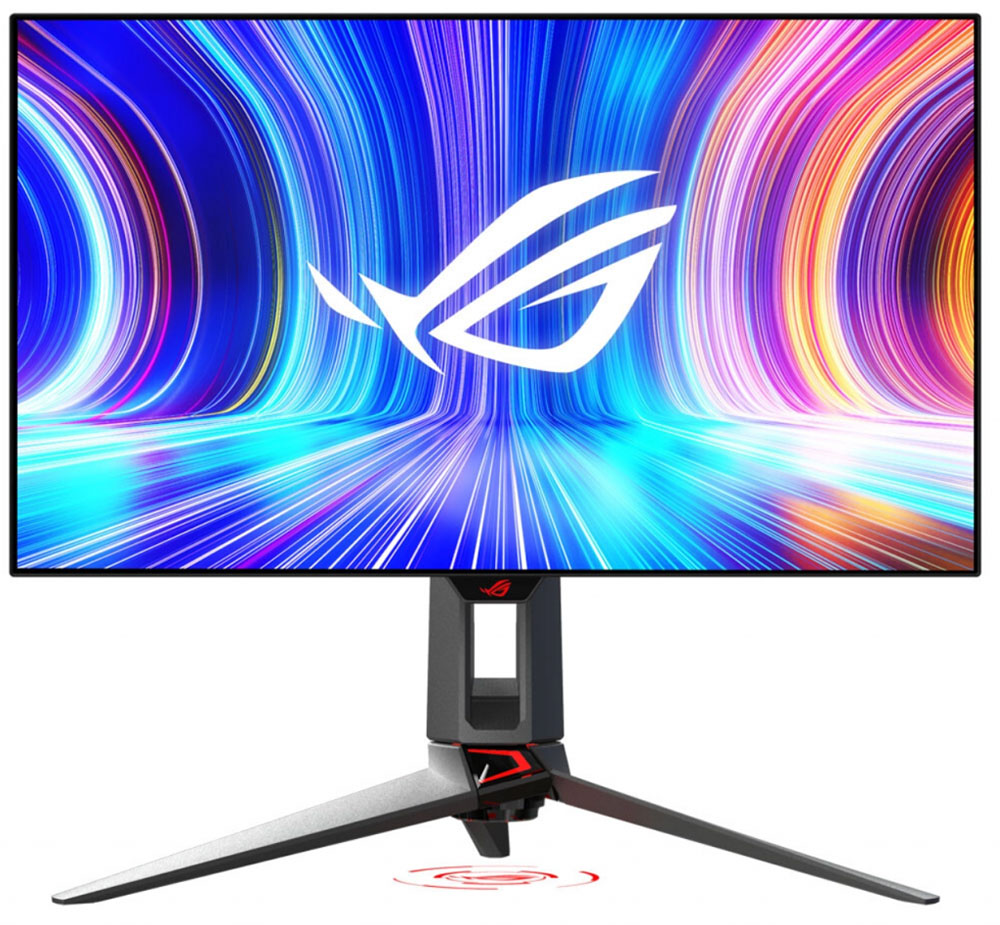
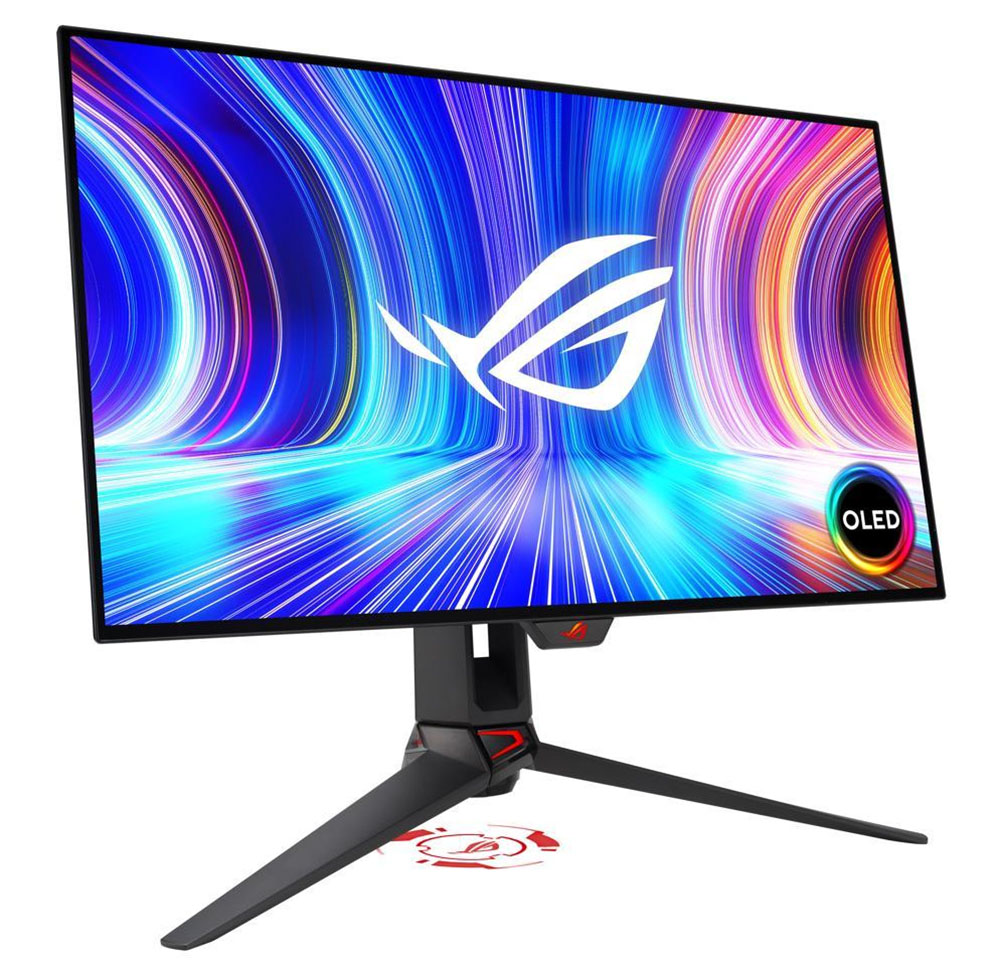
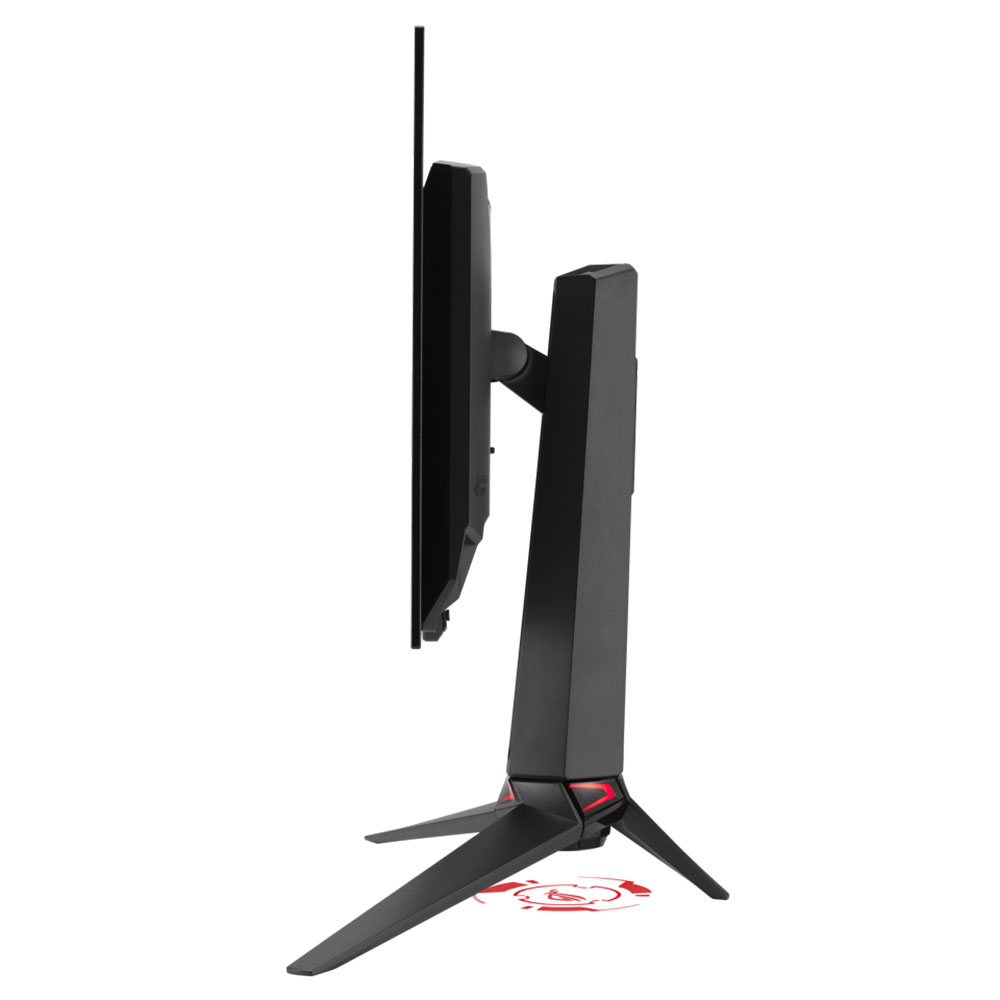
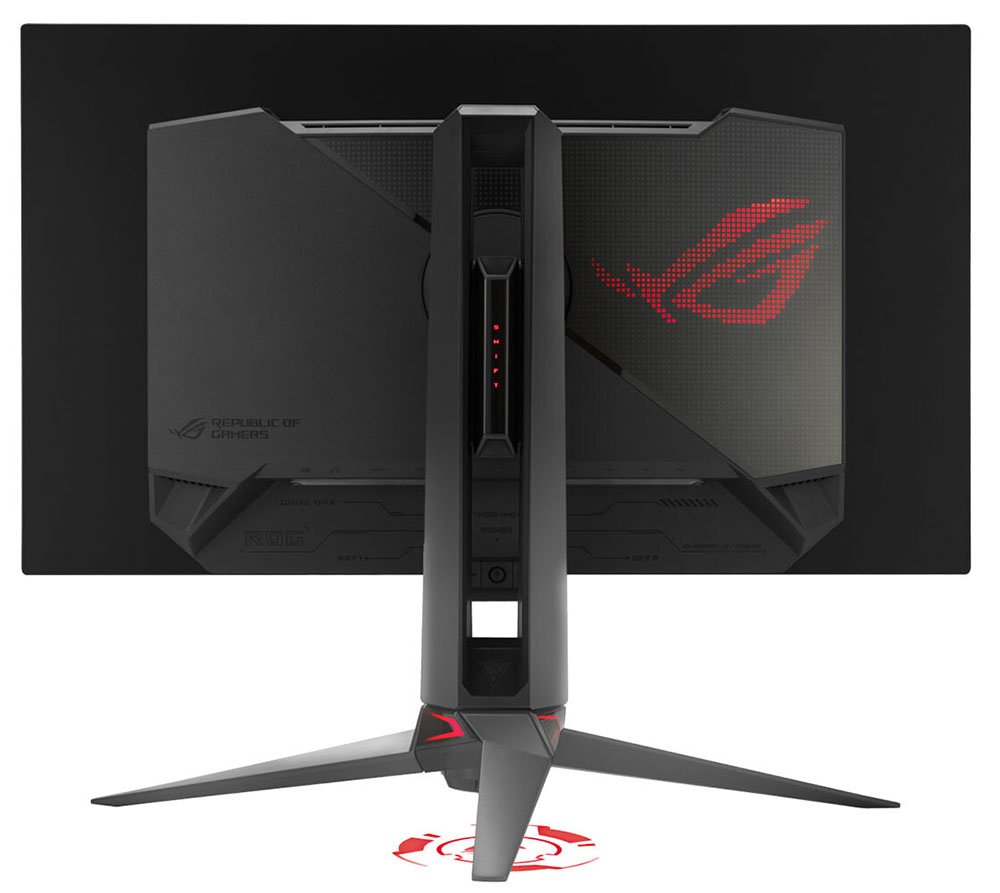
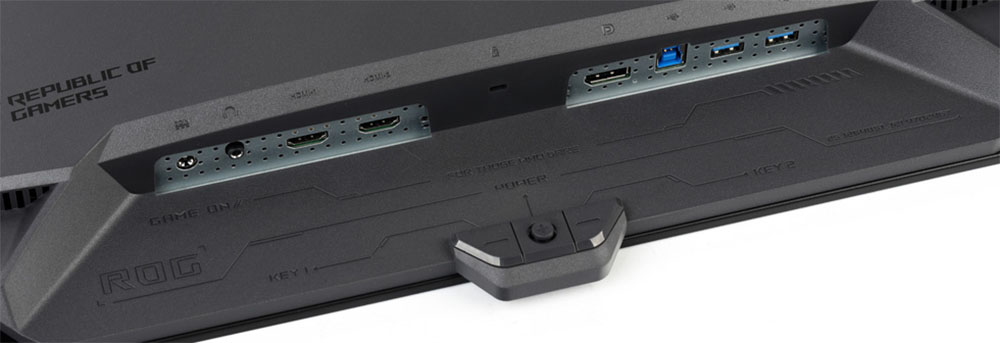
The PG27AQDM has relatively understated styling compared to other ROG displays. You won’t find the molded lines that look like spaceship hull plating here. The screen has an anti-glare layer that’s shinier than most LCDs but less so than a typical OLED television. I had no issues with reflections in my sunlit office.
The back features a large ROG logo backlit by LEDs in a pixelated design. It also says “Swift” in tiny letters on the upright. This bar goes up and down with the panel. The stand also features LED accents and a projector that puts the ROG logo on your desktop. All the lighting is controlled in the OSD with various colors and effects, or you can turn it off.
The stand offers full ergonomics with 110mm (4.3 inches) height, 30 degrees swivel, 5/20 degrees tilt and a 90-degree portrait mode. You can rotate the panel in either direction. All movements are super tight and free of play. My only nitpick is that there’s no detent for the rotation, so I had to use a level to get the monitor perfectly straight.
At the bottom center of the screen is a tiny protrusion with a backlit ROG logo. Behind this are two control keys and a joystick for the OSD. The bezel is super thin, with just 9mm of flush framing around the top and sides and 11mm at the bottom. The panel is thin as well. With the component bulge, it’s 50mm (2 inches) deep, but apart from that, it’s just 5mm thick. If you’d rather use your own mount, a stamped steel adaptor bracket is included with a 100mm VESA lug pattern.
Inputs are up and under with a DisplayPort 1.4 (w/DSC), two HDMI 2.0 and USB, one upstream and two down. There are no internal speakers, but you get a 3.5mm headphone jack.
OSD Features
The OSD is extensive but relatively simple to navigate. You won’t find many video processing options like overdrive or blur reduction because they aren’t necessary. There are plenty of calibration controls, lighting menus, and other convenience features.
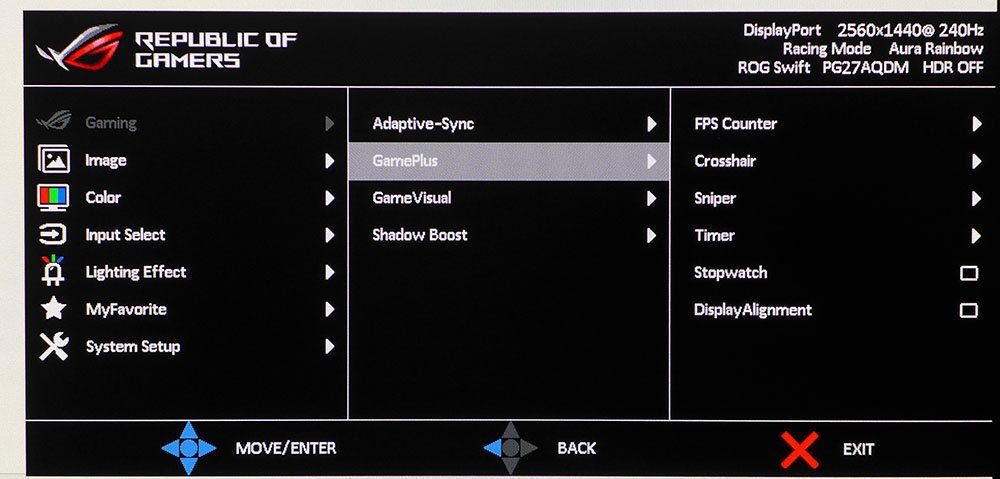
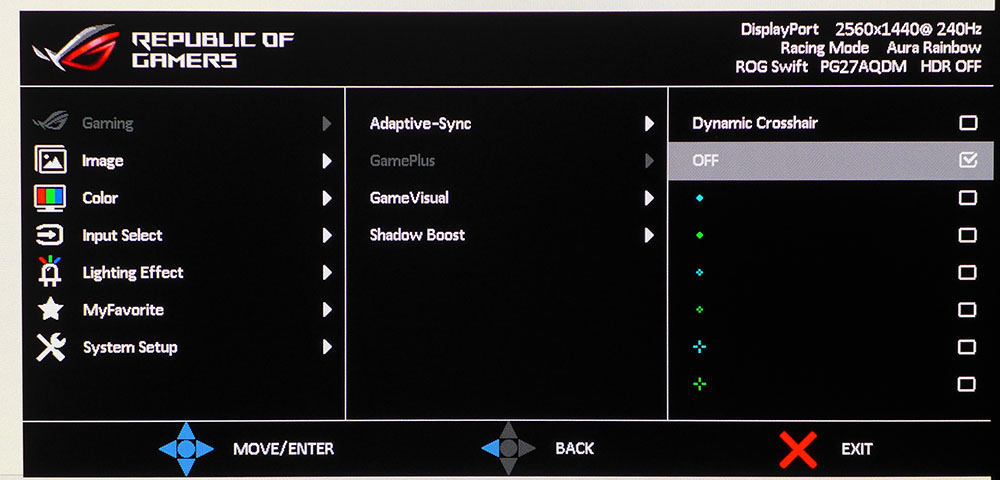
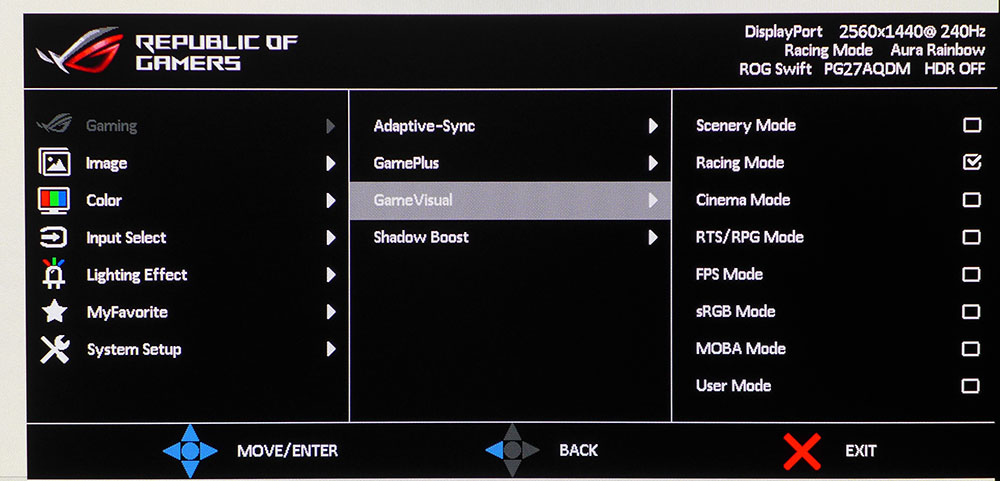
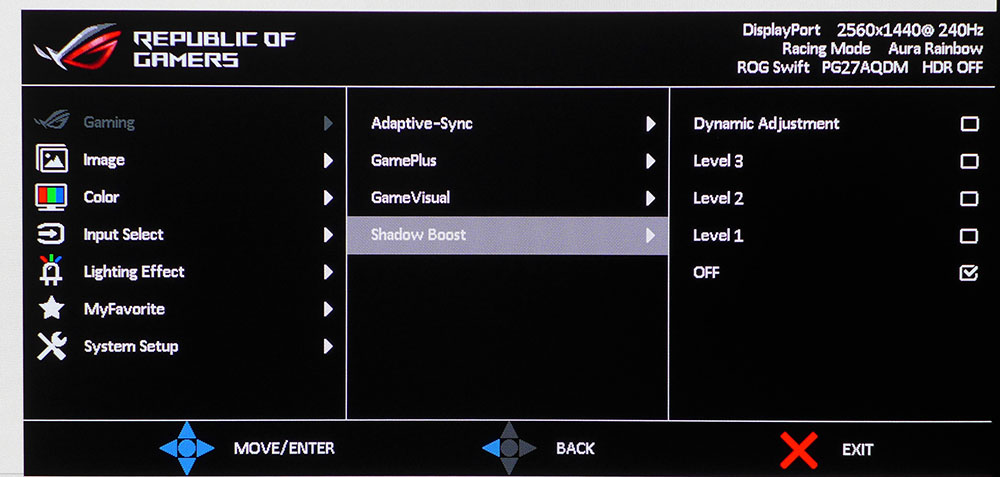

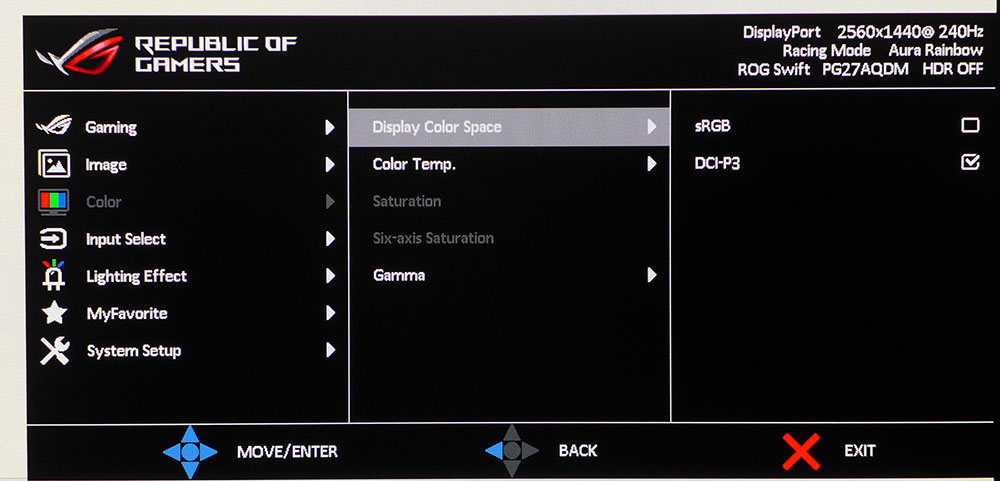
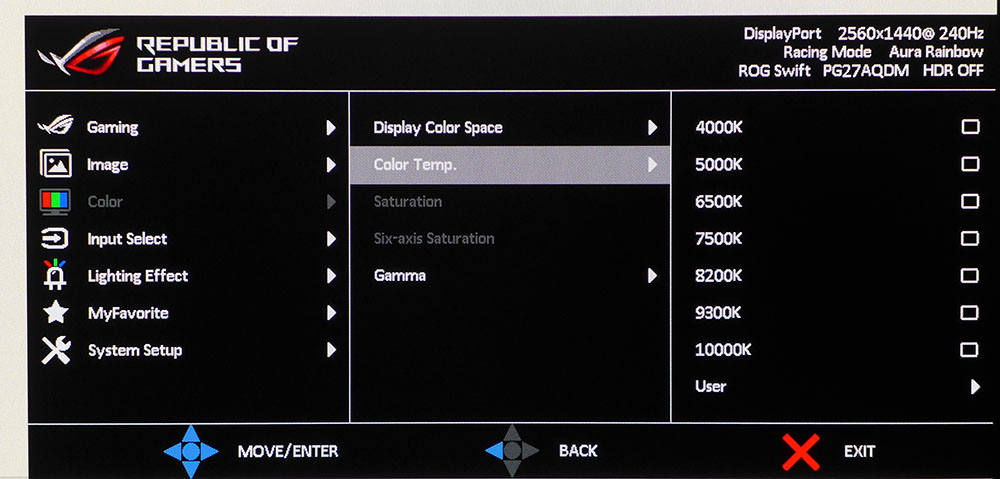
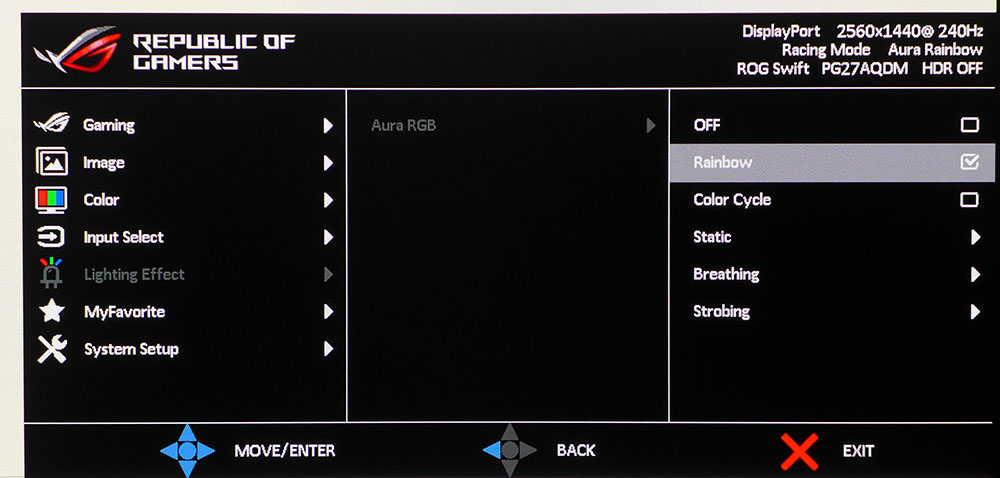
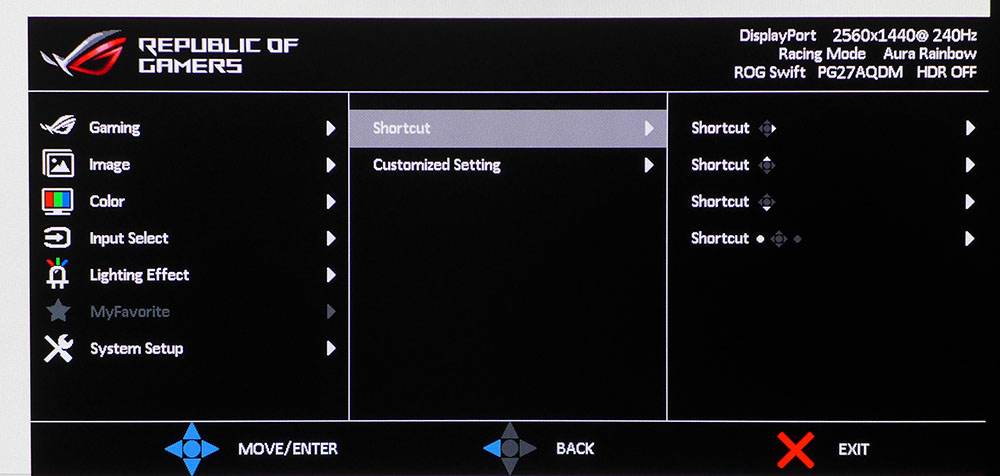
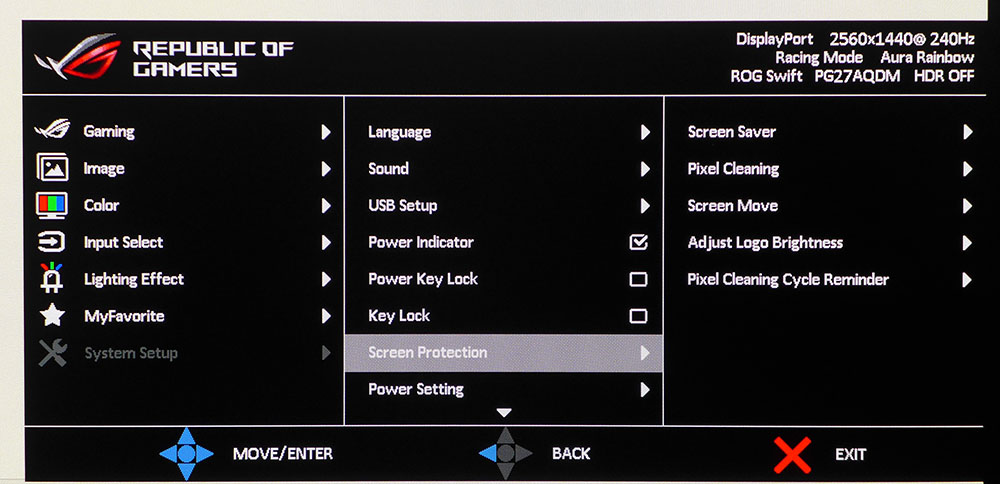
Asus users will have seen the PG27AQDM’s OSD before. It’s laid out in a familiar fashion, starting with the Gaming sub-menu. You can toggle Adaptive-Sync and choose between a full set of Game Plus enhancements like aiming points, timers, stopwatch, frame counter and a sniper mode that magnifies the center of the screen. GameVisual is the nine picture modes; Racing is the default, and you can leave the monitor set to that mode and enjoy a near-perfect image with no tweaking required. Shadow Boost has three levels and an automatic mode that works a bit like dynamic contrast. I did not need this in the games I played, so I left it off.
The Image menu has traditional luminance sliders and a uniformity option. This was unnecessary on my sample and only served to dim the picture. A Blue Light Filter alters the image to reduce fatigue during long work sessions.
You can calibrate the PG27AQDM in several ways. There are selectable gamuts, sRGB or DCI-P3, as well as color temps by Kelvin value from 4,000 to 10,000K, and a user mode with RGB sliders. I only made a tiny improvement using them, so I recommend leaving this set to 6500K. You can also pick from five gamma presets ranging from 1.8 to 2.6.
The Aura RGB lighting refers to the logo projector and the graphic on the panel’s backside. There are multiple effects and colors available, or you can shut the whole thing off for a stealthy look.
The joystick’s directional movements can be assigned to shortcuts like brightness or picture mode, which is handy for quick access when you don’t want to dig through the OSD.
Users concerned about OLED burn-in will find an array of screen protection features like a screen saver, pixel cleaner and an orbiter that shifts the image by one or two pixels. This operation is entirely invisible. Adjust Logo Brightness dims the bottom right corner of the screen where TV channel logos often reside. The Pixel Cleaning Reminder can be set to remind you every two, four or eight hours to run the routine. It takes about six minutes and begins after the monitor enters standby mode.
Asus ROG Swift PG27AQDM Calibration Settings
In the PG27AQDM’s Racing mode, no calibration is necessary. In fact, my adjustments barely made a difference. If any monitor can be called “factory calibrated,” it’s this one. To set brightness, I measured 25% window patterns rather than full fields. Brightness is reduced as more of the screen lights up. I’ll talk more about this on the next page. I arrived at the settings below using that test method, but you may want to turn the brightness up more if your room is well-lit. The default color gamut is DCI-P3 which the PG27AQDM covers almost 97% of. If you want sRGB, there’s a gamut option that works in the Racing picture mode or an sRGB picture mode. The latter is a more accurate choice.
In HDR mode, three additional picture modes exist: Gaming, Cinema and Console. Gaming is the best choice. You can also turn on a brightness adjustment to tone down the image. I had no need for this. The PG27AQDM’s HDR is about as good as it gets right out of the box.
| Picture Mode | Racing |
| Brightness 200 nits | 53 |
| Brightness 120 nits | 36 |
| Brightness 100 nits | 28 |
| Brightness 80 nits | 21 |
| Brightness 50 nits | 11 (min. 21 nits) |
| Contrast | 80 |
| Gamma | 2.2 |
| Color Temp User | Red 99, Green 97, Blue 83 |
Gaming and Hands-on
Using an OLED panel as an everyday monitor is an absolute treat. Every kind of image, static or moving, is made better by the PG27AQDM’s incredible contrast. Blacks are truly black but still rich with detail. Though I had calibrated my sample, the change from its out-of-box state was invisible. You don’t need to adjust this monitor aside from setting brightness, which requires trial and error. I initially set the level using a 25% window pattern to 200 nits. That proved a little too dark when viewing fullscreen content. I turned the slider up to 60, which is the default value. This matched the image better to my sunlit office. You will find that some tweaking is necessary to find a comfortable level for your space.
Color saturation is quite high but never overblown. I had no complaints using the PG27AQDM’s full native gamut for all content. I only reached for the sRGB mode when editing photos. There, you’ll want to be sure you’re grading color properly for monitors that don’t have a wide gamut.
The contrast is so deep that the QHD resolution is a non-factor. You can see the pixel structure if you put your face right up to the screen. But OLED always looks sharper to me than an LCD running at the same resolution. It’s a visual perception because the actual pixel gap is about the same between the two panel types. There’s that contrast again. It always adds to the perception of fine detail and clarity. Document editing is easy and comfortable thanks to the broad range between black fonts and white background.
Gaming is an enhanced experience on two levels. Image quality is tremendous, with realistic environments and fine detail that pops from the background. Character faces are realistically textured with a tactile feel. Video processing is also enhanced. There’s no overdrive to tweak because motion resolution is perfect without it.
I played my usual game suite of Tomb Raider, Call of Duty WWII and Doom Eternal at max detail at 240fps. With the recent addition of a GeForce RTX 4090 to my test PC, I can now play at the full potential of the fastest monitors available. I have observed that all OLEDs are smoother than LCDs running at the same frame rate. I get better motion resolution from the PG27AQDM at 240fps than from a 240 Hz QHD LCD like the BenQ EX270QM. I also noticed the incredibly low input lag. This monitor is one of the quickest I’ve ever tested. It is completely qualified for professional competition gaming.
When a monitor is this responsive, it’s far easier to aim on the move and fire when you intend to. Defensive movements are also more natural and controlled because you can start and stop exactly when and where needed. This level of precision makes gaming far more addictive and comfortable. I felt as though the PG27AQDM and my peripherals were simply extensions of my hands and eyes.
I’m not sure it’s possible to overstate the high playability and premium feel of this monitor. It also delivers a stunning image making it hard to find any faults. I experienced no problems during my many hours of gameplay. I also used the PG27AQDM for work tasks and found it a pleasurable experience.
If you’re wondering about burn-in, I can only say that I didn’t use the monitor long enough to create any. OLEDs are not immune to this, and I recommend using the panel maintenance features Asus includes. The pixel cleaner takes about six minutes to run and only starts once you put the PG27AQDM in standby mode, so it’s completely non-intrusive. I left the pixel orbiter (Screen Move) on, and it never showed its operation. My only long-term experience with an OLED panel is the 65-inch LG GX-series television I’ve used daily for over two years. It shows no signs of burn-in at all.
MORE: Best Gaming Monitors
MORE: How We Test PC Monitors
MORE: How to Buy a PC Monitor: A 2022 Guide
MORE: How to Choose the Best HDR Monitor
Current page: Features and Specifications
Next Page Response, Input Lag, Viewing Angles and Uniformity
Christian Eberle is a Contributing Editor for Tom's Hardware US. He's a veteran reviewer of A/V equipment, specializing in monitors. Christian began his obsession with tech when he built his first PC in 1991, a 286 running DOS 3.0 at a blazing 12MHz. In 2006, he undertook training from the Imaging Science Foundation in video calibration and testing and thus started a passion for precise imaging that persists to this day. He is also a professional musician with a degree from the New England Conservatory as a classical bassoonist which he used to good effect as a performer with the West Point Army Band from 1987 to 2013. He enjoys watching movies and listening to high-end audio in his custom-built home theater and can be seen riding trails near his home on a race-ready ICE VTX recumbent trike. Christian enjoys the endless summer in Florida where he lives with his wife and Chihuahua and plays with orchestras around the state.
-
oofdragon If I lived on USA and got paid in dollars, I wouldn't even consider this expensive, at all. People complaining about the 4070 being $600.. just imagine having to pay $800 for the cheapest ass 1440p IPS 144hz or $2400 for a 3060. In Brazil my friends that's what it cost. A 5K gaming rig here is really as good as a 144hz IPS monitor powered by a 3060, so really, if you live in USA (and EUR) stop complaining about price. If I can afford a 5k gaming rig in Brazil you surely can afford a 5k gaming rig in USA unless you are unemployed or you didn't figure how to make good use of your money. I work as a Uber driver, have two kids, live in front of the beach. If I can, bro you surely can as well, just plan ahead and save money 3 to 4 months, stop expending in unnecessary stuff and you'll get there.. with a OLED 240HZ and a RTX 4090 while we international fellas will wait another 6 or 10 years to have it accessible for us.Reply
EDIT: the minimum wage here is R$1300 while in US is $1300 so I used "$" as "money", not dollars. A 3060 here is R$2400 (roughly $480 dollars) -
Sonik35143 Reply
If you lived in the USA you would know that a 2 bedroom apartment can cost $1500-$2000 a month to rent in areas with decent pay. You would also know that going to the doctor can cots $150 for 15 minute visit or that a visit to the emergency room can cost thousands or dollars and bankrupt you or take away your life savings. Electronics can be cheap compared to the rest of the world but everything else is stacked against you.oofdragon said:If I lived on USA and got paid in dollars, I wouldn't even consider this expensive, at all. People complaining about the 4070 being $600.. just imagine having to pay $800 for the cheapest ass 1440p IPS 144hz or $2400 for a 3060. In Brazil my friends that's what it cost. A 5K gaming rig here is really as good as a 144hz IPS monitor powered by a 3070, so really, if you live in USA stop complaining about price. If I can afford a 5k gaming rig on Brazil you surely can afford a 5kngaming rig on USA unless you are unemployed or you didn't figure how to make good use of your money. I work as a Uber driver, have two kids, live in front of the beach. If I can, bro you surely can as well, just plan ahead and save money 3 to 4 months, stop expending in unnecessary stuff and you'll get there.. with a OLED 240HZ and a RTX 4090 while we international fellas will wait another 5 or 10 years to have it accessible for us. -
healthy Pro-teen Reply
$2400 for a 3060 is mental, I found a 3060Ti for $330 used and I am from Pakistan. Even the Xeneon flex ( spent $1849, Only 240Hz OLED that was available, atleast it's a bendable 45 inch UW) and Aorus 7900XTX I have were reasonable ($1219, cost $1100 something in US), only the 4090 is $2k used which is a bummer, but I shouldn't complain because that's still cheaper than that 3060 there. I am jobless ( under 17) and my parents decide my PC's budget, thankfully it's more on the generous side.oofdragon said:If I lived on USA and got paid in dollars, I wouldn't even consider this expensive, at all. People complaining about the 4070 being $600.. just imagine having to pay $800 for the cheapest ass 1440p IPS 144hz or $2400 for a 3060. In Brazil my friends that's what it cost. A 5K gaming rig here is really as good as a 144hz IPS monitor powered by a 3070, so really, if you live in USA stop complaining about price. If I can afford a 5k gaming rig on Brazil you surely can afford a 5kngaming rig on USA unless you are unemployed or you didn't figure how to make good use of your money. I work as a Uber driver, have two kids, live in front of the beach. If I can, bro you surely can as well, just plan ahead and save money 3 to 4 months, stop expending in unnecessary stuff and you'll get there.. with a OLED 240HZ and a RTX 4090 while we international fellas will wait another 5 or 10 years to have it accessible for us. -
oofdragon ReplySonik35143 said:If you lived in the USA you would know that a 2 bedroom apartment can cost $1500-$2000 a month to rent in areas with decent pay. You would also know that going to the doctor can cots $150 for 15 minute visit or that a visit to the emergency room can cost thousands or dollars and bankrupt you or take away your life savings. Electronics can be cheap compared to the rest of the world but everything else is stacked against you.
But that's exactly my point.. my rent is $2000 and doctor here is $300 a single visit, it's not different at all. I spend no kidding $2500 a month with food, cleaning etc.. the only real difference is that the money that is left when all the bills are paid is simply not enough to buy a rtx 3060 which costs here S2400, but that I can afford if I save up for several months. If you live in the US you can buy this OLED, a 5800x3d and a RTX 4080 with the same "spare money" I can afford a measly 3060. And honestly here in Brazil, the average person earning 5 times less than someone born in US, we r still pretty good compared to other countries that are double poor. My reasoning is that anyone living in the US complaining about these prices is either unemployed or a cry baby, may sound harsh but my honest opinion.
Btw.. just to share a personal bill I had recently, while in Brazil you have free access to ER, I spent last month $8000 in medical bills because the service I needed with haste wasn't available for free.. so yeah, it's tough for everyone. -
oofdragon Replyhealthy Pro-teen said:$2400 for a 3060 is mental, I found a 3060Ti for $330 used and I am from Pakistan. Even the Xeneon flex ( spent $1849, Only 240Hz OLED that was available, atleast it's a bendable 45 inch UW) and Aorus 7900XTX I have were reasonable ($1219, cost $1100 something in US), only the 4090 is $2k used which is a bummer, but I shouldn't complain because that's still cheaper than that 3060 there. I am jobless ( under 17) and my parents decide my PC's budget, thankfully it's more on the generous side.
Lol my bad.. I didn't make it clear that "$" equals "money" in the values I shared. I wrote like that because in Brazil the minimum wage is around R$1300 while in USA it's around $1300. The other guy answered his rent can cost as much as $2000.. while my rent also costs me R$2000.. but while $2400 can buy him a RTX 4080 plus the OLED and a CPU upgrade, everything new, here R$2400 (roughly $480) can buy me a second hand RTX 3060. And btw.. your gear, that's so much money here In Brazil it could buy you a wife -
oofdragon About the monitor.. someday in the future when I make the jump from 24"1080p, after so many years, I definitely won't be upgrading to a 27"1440p, that feels like way to little of a improvement, even if it's OLED and 240hz. I don't understand why someone would today choose this one over the 34"3440p 165hz when the prices almost match, rlly. While it seems I wouldnt miss those extra fps, the other way around giving up the extra screen immersion rlly feels like a compromise I wouldn't make. This Asus looks like the endgame monitor before we get to the 1000hz era, what I trully want as a upgrade is this exact performance here but 34" 3440p. That's my endgame, paired with a neo qled 65" 8K 120Hz (if I can't afford the OLED)Reply -
helper800 Reply
You cannot compare like this, it does not make sense... Try this.oofdragon said:Lol my bad.. I didn't make it clear that "$" equals "money" in the values I shared. I wrote like that because in Brazil the minimum wage is around R$1300 while in USA it's around $1300. The other guy answered his rent can cost as much as $2000.. while my rent also costs me R$2000.. but while $2400 can buy him a RTX 4080 plus the OLED and a CPU upgrade, everything new, here R$2400 (roughly $480) can buy me a second hand RTX 3060. And btw.. your gear, that's so much money here In Brazil it could buy you a wife -
DavidLejdar Reply
Myself, in Berlin, I have a bit of money left at the end of the month, which I can save up for e.g. hardware, or for going to a concert, etc. But e.g. in Texas, the minimum wage is $7.25 per hour, which applies to around 400,000 workers there. In most places there, more than half of that will go towards rent, which doesn't really leave much for saving up, in particular in places such as Dallas County, where it takes a living wage of nearly $18 per hour for a single adult to just support their basic needs.oofdragon said:If I got paid in dollars, ...
Similarly in Brazil, if you'd be having minimum wage, you'd cover only half of what your current living costs are, wouldn't you? Which isn't to say that there aren't some with higher income, who are boozing it away, or some who may at least try to apply for a job, instead of hoping to get hardware for free. But to imply that everyone with a job surely can afford the highest-end rig there is, that's generalizing it too much, isn't it? -
GustavoVanni Reply
Well, if you consider that today April 24th 2023 1USD equals 5,05BRL, your interpretation of how much it costs us to live here in Brazil is what does not make sense...helper800 said:You cannot compare like this, it does not make sense... Try this.
You have to take into consideration that you guys are payed in USD and us in BRL, but we don't get payed 5,05 times the value that you get. We actually are payed half or even less than what a minimum wage american gets.
The bare minimum wage in US is 7,50 USD per hour, some states pay a little more and some pay almost double of that.
Here in Brazil I get payed less than half of that 7,50USD per hour.
And my monthly salary is actually more than two brazilian minimum wage.
For every hour that a "lowest minimum wage american" works, I have to work more than double of that to get the same amount of money.
But if I was payed the brazilian minimum wage, I would have to work almost 5 times more than the "lowest minimum wage american" to get the same money... So now you start to get an idea of what oofdragon is trying to say.
Look at a "McMeal at McDonalds (or Equivalent Combo Meal)", it costs you "only" 10 bucks, that is about 1h20min of work at max for an american, but for us here in bananaland it costs 35BRL, which is almost 6 hours of work if you get payed minimum wage!!!
But I guess noone here in Brazil is eating McDonalds every day, so lets compare something that is more common in everyday life.
Milk (regular), (1 liter) costs you 8min14sec of work to buy, but costs us 59min48sec.
Rice (white), (1kg) costs you 20min, but to us it's 1h2sec.
Beef Round (1kg) (or Equivalent Back Leg Red Meat) costs you 1h48min43sec, to us it's 7h32min56sec.
Gasoline (1 liter) is 9min51sec for you, it's 1h5min22sec for us.
A Toyota Corolla Sedan 1.6l 97kW Comfort (Or Equivalent New Car) costs you 3,435h35min21sec, and to us it's 23,694h5min44sec, and we have to pay 5% of the value of the car per year in a tax until the car is 20 years old. Yeah, that's true. We pay a lot for the car itself, which already has a lot of taxes included in its pricetag, and then we still have to pay "another car" to the government in a stupid tax until the car is 20 years old!! Brasil-sil-sil!!!
And let's not forget the pride and jewelry of our beloved country, a Banana (1kg) costs you 13min7sec and 1h9min56sec to us plebs.
To sum it up, because I know nobody will read all this crap I just wrote, what oofdragon and I are trying to say is that we (and most people around the world to be honest...) have to work much more to buy the same things that someone in US or another rich country have to.
We don't mean to say that a 1,000,00 USD OLED Monitor is 'cheap' by any means, but is 'cheaper' to you guys than to the rest of the world.
